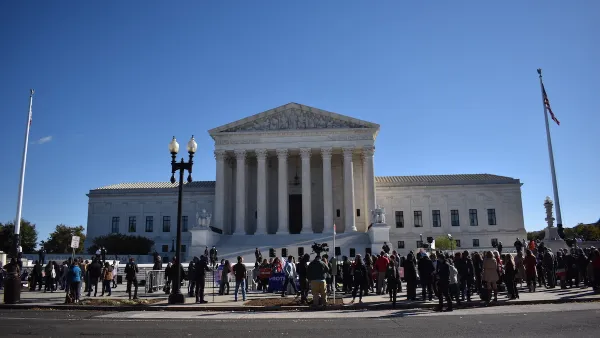The Supreme Court might decide on the constitutionality of inclusionary zoning. Local land use regulations and affordable housing policies in cities and communities all over the country hang in the balance.

Kriston Capps reports on the background and details of a court case expected to appear before the Supreme Court that amounts to whether inclusionary zoning is an unconstitutional government taking of private property.
The court case was born in Marin County, where two property owners, Dartmond and Esther Cherk, were forced to either include affordable housing or pay an in-lieu fee when trying to develop a residential parcel into two single-family-zoned lots.
Capps explains the stakes of a possible Supreme Court hearing for Dartmond Cherk, et al. v. Marin County, California.
The Marin County case may test the constitutionality of inclusionary zoning, a tool that local jurisdictions rely on to expand the supply of affordable housing, especially in tight housing markets. The court has expressed an interest in the case, which the justices may wind up using as a wedge to reshape property rights. It’s possible the inclusionary zoning ordinances—and local regulations more broadly construed—will not stand under the court’s scrutiny.
Capps explains the status of the case relative to the Supreme Court's interest in deciding the matter. "Housing advocates and industry associations are filing briefs on both sides of the case," according to Capps, and "the court asked Marin County for its response, which attorneys must file by October 7."
The Supreme Court's position on whether inclusionary zoning amounts to an unconstitutional taking could also have implications for land use regulations that have environmental outcomes in mind, according to Capps.
FULL STORY: Will the Supreme Court Strike Down Inclusionary Zoning?

Analysis: Cybertruck Fatality Rate Far Exceeds That of Ford Pinto
The Tesla Cybertruck was recalled seven times last year.

National Parks Layoffs Will Cause Communities to Lose Billions
Thousands of essential park workers were laid off this week, just before the busy spring break season.

Retro-silient?: America’s First “Eco-burb,” The Woodlands Turns 50
A master-planned community north of Houston offers lessons on green infrastructure and resilient design, but falls short of its founder’s lofty affordability and walkability goals.

Test News Post 1
This is a summary

Analysis: Cybertruck Fatality Rate Far Exceeds That of Ford Pinto
The Tesla Cybertruck was recalled seven times last year.

Test News Headline 46
Test for the image on the front page.
Urban Design for Planners 1: Software Tools
This six-course series explores essential urban design concepts using open source software and equips planners with the tools they need to participate fully in the urban design process.
Planning for Universal Design
Learn the tools for implementing Universal Design in planning regulations.
EMC Planning Group, Inc.
Planetizen
Planetizen
Mpact (formerly Rail~Volution)
Great Falls Development Authority, Inc.
HUDs Office of Policy Development and Research
NYU Wagner Graduate School of Public Service




























